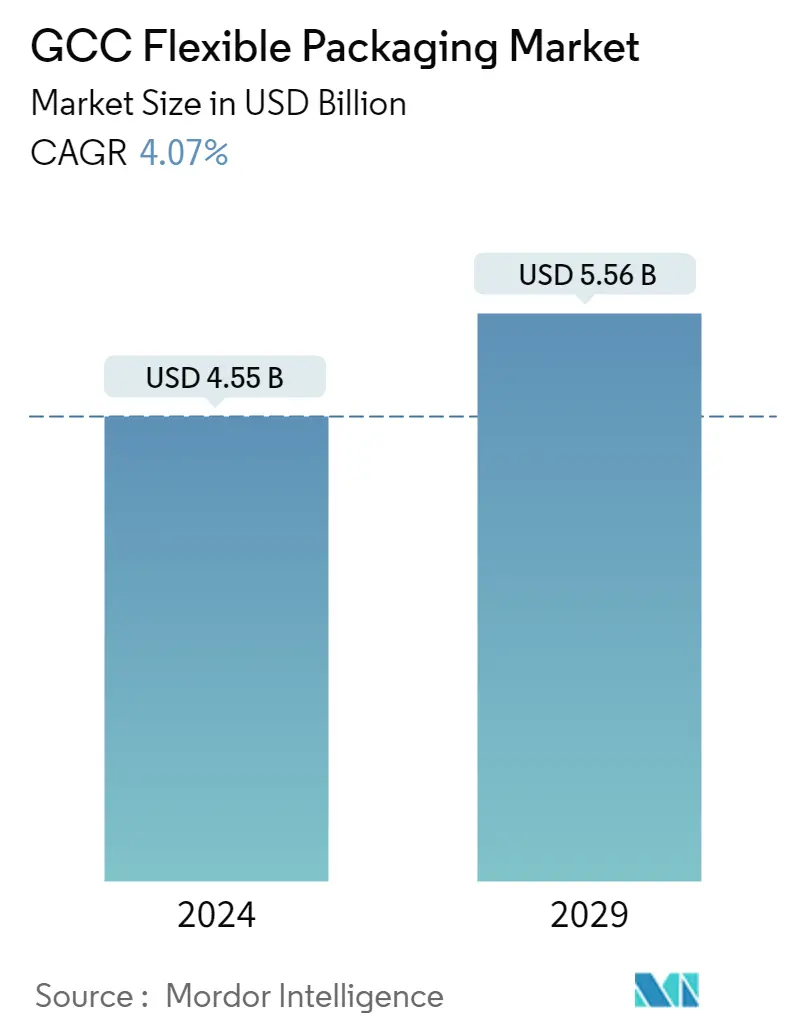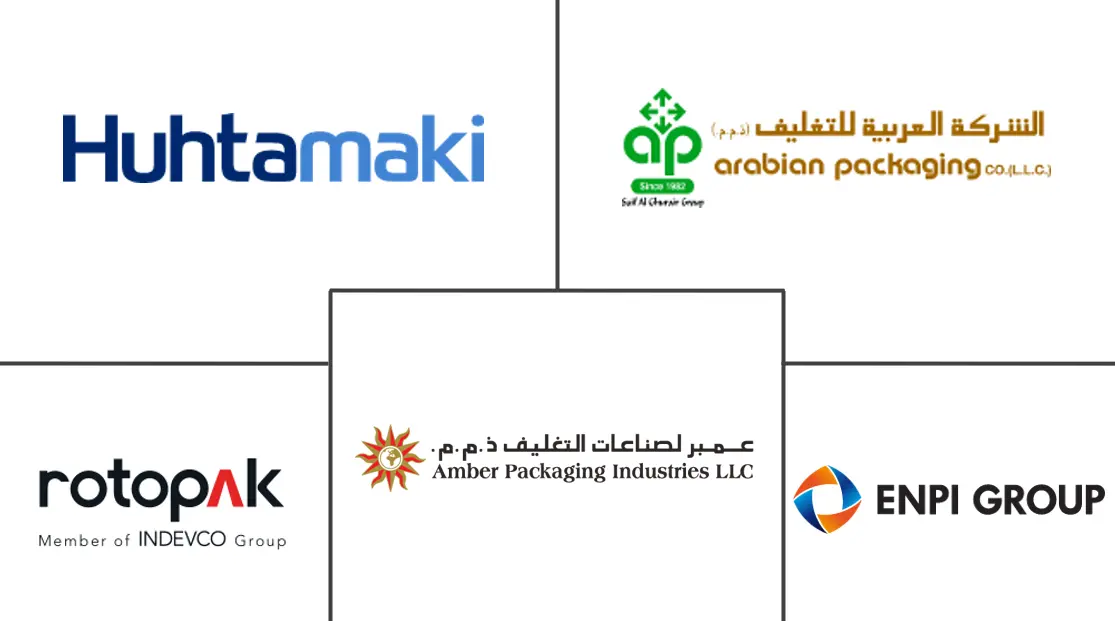Market Size of GCC Flexible Packaging Industry

| Study Period | 2019 - 2029 |
| Base Year For Estimation | 2023 |
| Market Size (2024) | USD 4.55 Billion |
| Market Size (2029) | USD 5.56 Billion |
| CAGR (2024 - 2029) | 4.07 % |
| Market Concentration | Low |
Major Players
*Disclaimer: Major Players sorted in no particular order |
GCC Flexible Packaging Market Analysis
The GCC Flexible Packaging Market size is estimated at USD 4.55 billion in 2024, and is expected to reach USD 5.56 billion by 2029, growing at a CAGR of 4.07% during the forecast period (2024-2029).
Economic expansion and increased disposable incomes among the workforce are expected to drive market growth in the region during the forecast period.
- The GCC is considered one of the critical markets for the packaging industry in the Middle Eastern region. The primary production industry of the area is the oil and gas sector, which drives most of the country's business revenues. Increased output from various end-use industries, such as food, retail, consumer goods, pharmaceuticals, etc., will increase demand for flexible packaging in the country.
- For instance, according to Saudi Arabia's Ministry of Commerce and Industry, the soft drinks and beverage industries are now among some of the mature sectors in the country, constituting a vast majority of the food and beverage sectors' exports. Most manufacturers are introducing additional functionalities of EVOH films for packaging. Functionalities, such as its cost-effectiveness and high seal strength, have displayed a trend in EVOH films for packaging. EVOH films are used for a food packaging solution, as they can successfully retain the properties of food products, thereby preventing contamination during shipments.
- The increasing trend of consumer products such as food, beverages, and pharmaceuticals is expected to increase the demand for flexible packaging in the region. The growing need for convenient, portable packaging solutions drives increased demand. As the region becomes more urbanized, there is a higher focus on sustainability and convenience in packaging. The general trend to move to flexible packaging is to take advantage of processed food packages and adapt to changing lifestyles.
- Additionally, urbanization and changing demographics have significantly impacted the packaging sector, which is progressively expanding. Additionally, it is affected by shifting consumer trends and behaviors. Changes in income patterns and the associated disposable income have impacted the demand for packaging materials across many sectors.
- However, growing concerns regarding the environment and recycling in the region may restrain the market growth. The region faces a shortage of flexible packaging recycling facilities, which affects the development of proper recycling and the safe disposal of flexible packaging products.
- Flexible packaging manufacturers in the area faced several difficulties due to the COVID-19 outbreak. The effects of the lockdown included disruptions in the supply chain, a scarcity of raw materials needed for production, a labor shortage, and changing prices that drove up the cost of production, shipping problems, and so on. Further, the Russia-Ukraine war impacted the overall packaging ecosystem in the GCC region.
GCC Flexible Packaging Industry Segmentation
The study covers the flexible packaging market tracked in terms of consumption and is only limited to flexible packaging products made from plastic, paper, and metal (aluminum). The market numbers are derived by tracking the revenue generated by the players operating in the market who are providing flexible packaging products. This report analyzes the factors influencing the impact of COVID-19 on the studied market based on the prevalent base scenarios, key themes, and end-user vertical-related demand cycles.
The market considers revenues accrued from the sales of flexible packaging products, i.e., the consumption of packaging material in the GCC region. The study also factors in the export-import of flexible packaging materials, the planned ban on plastic (including single-use plastics), etc., in the GCC region. The study also tracks the key market parameters, underlying growth influencers, and major vendors operating in the industry, which supports the market estimations and growth rates over the forecast period. The GCC flexible packaging market is segmented by material type (plastic, paper, metal), by product type (bags and pouches, films and wraps), by end-user industry (food, beverage, pharmaceutical, and medical, household, and personal care), and by country (Saudi Arabia, the United Arab Emirates, Qatar, and the rest of the GCC). The market sizes and forecasts are provided in terms of value in (USD) for all the segments.
| By Material Type | |
| Plastic | |
| Paper | |
| Metal |
| By Product Type | |
| Bags and Pouches | |
| Films and Wraps | |
| Other Product Types |
| By End-user Industry | |
| Food | |
| Beverage | |
| Pharmaceutical and Medical | |
| Household and Personal Care | |
| Other End-user Industries |
| By Country | |
| Saudi Arabia | |
| United Arab Emirates | |
| Qatar | |
| Rest of GCC |
GCC Flexible Packaging Market Size Summary
The GCC flexible packaging market is poised for significant growth, driven by economic expansion and rising disposable incomes across the region. As a critical market within the Middle Eastern packaging industry, the GCC benefits from its robust oil and gas sector, which underpins much of the region's economic activity. The demand for flexible packaging is expected to rise, fueled by increased output from various end-use industries such as food, retail, consumer goods, and pharmaceuticals. The trend towards urbanization and changing consumer lifestyles further propels the need for convenient and sustainable packaging solutions. However, environmental concerns and a lack of recycling facilities pose challenges to market growth, necessitating innovative approaches to packaging sustainability.
Saudi Arabia stands out as a major player in the GCC flexible packaging market, with its thriving food and beverage sectors driving demand. The country's growing population, coupled with lifestyle changes and state support, has led to a surge in disposable packaged foods and the entry of multinational companies. The market is characterized by a fragmented landscape with numerous domestic and international players, all vying to innovate and expand their offerings. Recent developments, such as the establishment of new manufacturing facilities and strategic partnerships, underscore the region's commitment to enhancing its packaging capabilities. As the market evolves, the focus on cost-effective, efficient, and sustainable packaging solutions remains paramount, aligning with broader economic and environmental goals.
GCC Flexible Packaging Market Size - Table of Contents
-
1. MARKET INSIGHTS
-
1.1 Market Overview
-
1.2 Industry Value Chain Analysis
-
1.3 Industry Attractiveness - Porter's Five Forces Analysis
-
1.3.1 Bargaining Power of Suppliers
-
1.3.2 Bargaining Power of Buyers
-
1.3.3 Threat of New Entrants
-
1.3.4 Threat of Substitutes
-
1.3.5 Intensity of Competitive Rivalry
-
-
1.4 Assessment of Impact of COVID-19 on the Market
-
-
2. MARKET SEGMENTATION
-
2.1 By Material Type
-
2.1.1 Plastic
-
2.1.2 Paper
-
2.1.3 Metal
-
-
2.2 By Product Type
-
2.2.1 Bags and Pouches
-
2.2.2 Films and Wraps
-
2.2.3 Other Product Types
-
-
2.3 By End-user Industry
-
2.3.1 Food
-
2.3.2 Beverage
-
2.3.3 Pharmaceutical and Medical
-
2.3.4 Household and Personal Care
-
2.3.5 Other End-user Industries
-
-
2.4 By Country
-
2.4.1 Saudi Arabia
-
2.4.2 United Arab Emirates
-
2.4.3 Qatar
-
2.4.4 Rest of GCC
-
-
GCC Flexible Packaging Market Size FAQs
How big is the GCC Flexible Packaging Market?
The GCC Flexible Packaging Market size is expected to reach USD 4.55 billion in 2024 and grow at a CAGR of 4.07% to reach USD 5.56 billion by 2029.
What is the current GCC Flexible Packaging Market size?
In 2024, the GCC Flexible Packaging Market size is expected to reach USD 4.55 billion.

